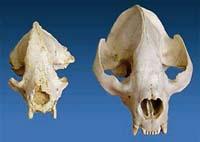The genome of Panda the great has revealed his carnality"
2009/12/15 Kortabitarte Egiguren, Irati - Elhuyar Zientzia

Researchers at the Beijing Genomics Institute have sequenced the Panda Grande genome and found that it has all the genes to digest meat, but not all the genes needed to digest the staple food, bamboo. because they have not found a genus of the enzyme cellulase. Therefore, intestinal bacteria are necessary to digest cellulose.
They have also seen that the T1R1 gene, the meat flavor receptor gene, is mutated. This could explain that despite being a carnivorous panda, it is herbivore.
According to the article published in the journal Nature, the large panda contains approximately 21,000 genes. Among the mammals that have sequenced so far, the dog stands out (80%). With man, on the other hand, it only resembles 68%. However, panda genetics have undergone fewer changes than the dog and man genetics, which have evolved more slowly.
They have also seen that it has a great genetic diversity, twice as much as human. Therefore, it has chances of survival, even if the population is reduced.Image courtesy of: Zhihe Zhang

Gai honi buruzko eduki gehiago
Elhuyarrek garatutako teknologia





